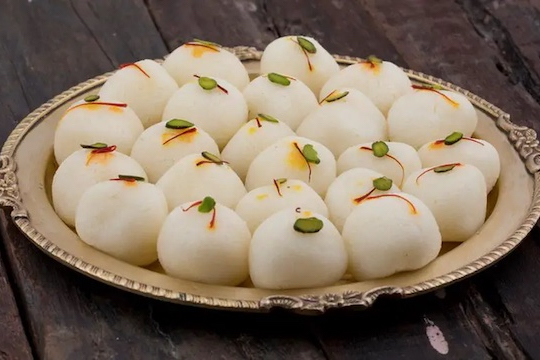No products in the cart.
A Journey Through the Famous Bengali Sweets of West Bengal
Bengal’s rich cultural heritage is complemented by its unparalleled legacy of sweets. Bengali sweets, or mishti, are famous across India and the world for their unique flavors, delicate textures, and artistry. From syrupy delights to milk-based creations, each region in West Bengal has its own signature sweets that reflect the traditions and tastes of the local people. Let’s take a sweet journey across the state and explore some of the most beloved treats from different parts of West Bengal.
1. Kolkata’s Iconic Rosogolla
No discussion of Bengali sweets is complete without the famous Rosogolla of Kolkata. This syrupy sweet, made from chhena (Indian cottage cheese) and soaked in sugar syrup, was popularized by the renowned confectioner Nobin Chandra Das in the 19th century. The soft, spongy texture and light sweetness make Kolkata’s Rosogolla a timeless favorite, so much so that it has gained geographical indication (GI) status, symbolizing its cultural heritage. Variations of Rosogolla include flavors like cardamom, rosewater, and saffron, adding new dimensions to this classic dessert.
2. Nadia’s Creamy Sarbhaja and Sarpuria
The district of Nadia is famous for two rich, milk-based sweets—Sarbhaja and Sarpuria. Sarbhaja consists of layers of thickened milk skin deep-fried and soaked in syrup, giving it a crunchy yet creamy texture. Sarpuria, on the other hand, is a softer version where milk solids are whipped and flavored with cardamom and saffron. Both these sweets are typically prepared during festivals and are known for their intricate layers and dense flavors. A visit to Krishnanagar, the main town of Nadia, isn’t complete without sampling these exquisite sweets.
3. Bardhaman’s Classic Sitabhog and Mihidana
Bardhaman district brings us two iconic sweets, Sitabhog and Mihidana, both of which hold a special place in Bengali cuisine. Sitabhog resembles fine rice, with tiny sweet rice balls flavored with ghee and cardamom, mixed with bits of fried gulab jamun. Mihidana, meanwhile, is a fine, granular sweet that resembles golden sand, made from gram flour, ghee, and saffron, then soaked in syrup. Both of these treats are especially popular during festivals and celebrations. Like Kolkata’s Rosogolla, these sweets also have GI status, showcasing their importance to Bengal’s culinary legacy.
4. Murshidabad’s Legendary Chhanabora
Murshidabad, with its historic royal heritage, has a sweet that lives up to its legacy—Chhanabora. This delicacy is a fried chhena (cottage cheese) sweet, which has a slightly crispy exterior and a soft, syrupy interior. The dark color of Chhanabora comes from its caramelized sugar coating, which adds a unique flavor. Originating from Baharampur in Murshidabad, this sweet is known for its rustic charm and is best enjoyed fresh, capturing the rich, deep flavors of caramelized sugar and cheese.
5. Bankura’s Talshash
Bankura offers a rare treat known as Talshash, which is especially popular during monsoon season. This seasonal sweet is made from tal (palm fruit), coconut, and jaggery, giving it a naturally sweet and slightly earthy flavor. The preparation requires skill, as the palm fruit has a sticky texture that’s carefully balanced with coconut and jaggery. Talshash is enjoyed more in rural areas and isn’t widely available outside Bankura, making it a must-try for those exploring regional Bengali sweets.
6. Malda’s Legendary Aamsandesh
Malda, known for its exceptional mangoes, brings us the delightful Aamsandesh, a mango-flavored twist on the classic Bengali sandesh. Made with fresh mango pulp and chhena, this sweet embodies the best of Malda’s mango season. Its soft, smooth texture and fruity flavor make Aamsandesh a refreshing summer delicacy. Though available only seasonally, it’s one of the most loved sweets in Bengal, drawing people from all over during mango season to savor its natural sweetness.
7. Hooghly’s Jolbhora Sandesh
Another classic from the Hooghly district is Jolbhora Sandesh, a sweet that brings surprise with every bite. Named Jolbhora (meaning “filled with water”) due to the syrup hidden inside, this sandesh is crafted with soft chhena, carefully molded to enclose a tiny amount of syrup or jaggery. Invented in the town of Chandannagar, Jolbhora Sandesh is a testimony to the artistry of Bengali confectioners. During winter, nolen gur (date palm jaggery) is often added, giving it a richer, caramel-like flavor and adding to its popularity.
8. Purulia’s Khirer Goja
Purulia brings a simple yet satisfying treat called Khirer Goja, which is a deep-fried sweet made from khoya (reduced milk) and flour. These crispy squares are often enjoyed with a dusting of sugar or dipped in syrup. Known for its long shelf life, Khirer Goja is a popular sweet to carry while traveling. Its light sweetness and flaky texture make it an everyday delight as well as a special treat for occasions.
Conclusion
Each region of West Bengal offers unique sweets that reflect its culture, seasonal produce, and culinary artistry. From Kolkata’s syrupy Rosogolla to Malda’s mango-flavored Aamsandesh, Bengal’s sweets provide a memorable experience for anyone with a sweet tooth. These treats are not just desserts; they are the essence of Bengali tradition, crafted with passion and skill, passed down through generations. So, next time you’re in West Bengal or at a Bengali sweet shop, make sure to try a variety of these delicacies and experience a taste of Bengal’s sweet heritage.

